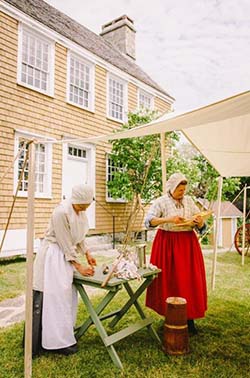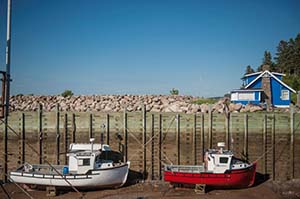At a wilderness area of rolling hills and waterways in Nova Scotia, Canada, the story of the people who lived there 4,000 years ago is told in periodic drumming demonstrations, birch bark canoe building and other activities.
The scene is very different in a nearby village. A number of its French-speaking residents are descendants of the man who founded the community in 1653, and restaurants serve food that would be at home in Paris.

And that’s just for starters. Visitors also are immersed in a tableau of fascinating history and an intriguing mix of cultures.
The story begins with the 4,000-year history of the Mi’kmaq people. Some of their ancestors still live around the village of Bear River. At the Kejimkujik National Park and Historic Site, petroglyph rock carvings serve as reminders of their presence, and visitors hike
ancient paths past former encampment areas and paddle along Mi’kmaq canoe routes.
The first recorded exploration in 1497 by a European, John Cabot of England, was followed by efforts to establish colonies by French explorers and later by settlers from Scotland. The 17th and early 18th centuries were marked by armed conflict between England and France over control of the territory, which finally reverted to Great Britain.
Other influences were added to the mix, each bringing new traditions and cultural touches. Some people who lived in the American colonies remained loyal to the British Crown and were forced to leave during the Revolution fled to the area, where they were greeted as United Empire Loyalists. Among them were Black Loyalists, whose descendants still reside in several communities in Nova Scotia.
Opportunities abound to experience each culture. The life of Acadians, descendants of original French colonists, may be explored and experienced in villages overlooking St. Mary’s Bay. French is the predominant language and the Acadian flag adorns many houses. At the Historic Village in West Pubnico, costumed interpreters provide an in-depth introduction to the area and its many stories.

Adventurous souls may opt for a unique tidal bore rafting experience, riding a crest of water created when the incoming tide meets the river outflow to generate 13-foot-high waves. During low tide, locals venture out on the exposed mud flats to gather clams for that evening’s dinner.
Clams, along with a variety of other seafood, make Nova Scotia the leading fishing province in Canada, but it’s another mollusk for which it’s best known. The town of Digby lays claim to the title “Scallop capital of the world” because it is home to a large scallop fishing fleet and the reputation of their haul for outstanding flavor.
Not surprisingly, many a restaurant menu includes Digby scallops in some form. Among ways I saw them prepared were pan seared, fried, grilled, encased in prosciutto, wrapped in bacon, on pizza, in salad and swimming in chowder.

If you can find time to spend a day to stroll through the centuries in Annapolis Royal, do it. The French established the first permanent European settlement in 1604, then the colony changed hands a number of times as the French and English battled for control of the area. After the final victory by England in 1710, it was named Annapolis Royal in honor of Queen Anne.
St. George Street in the middle of town is lined by buildings that represent three centuries. Among the oldest are a wooden house constructed in 1708 by a French officer and the 1710 home of a silversmith which later served as an inn and today houses a small museum.
Fort Anne in Annapolis Royal occupies one of the most hotly contested pieces of land in North America. Several forts were erected on the site beginning in 1629 and the fortress that stands today was built by the British. Visitors may walk the earthen walls that date back to 1702, explore a gunpowder magazine and check out the British field officers quarters, which houses an enticing museum.
![Fort Anne officers quarters 2[1]](https://travelersunited.org/wp-content/uploads/2016/08/Fort-Anne-officers-quarters-21.jpg)
A peek back at the lives of French-speaking settlers is one among many stories that bring the history of Nova Scotia to life. They combine with the area’s colorful cultures and magnificent scenery to offer something-for-everyone variety.
If you go
For information about visiting Nova Scotia, call (800) 565-0000 in North America, (902) 425-5781 elsewhere, or log onto novascotia.com.

After gallivanting throughout the United States and to more than 75 other countries around the world, and writing about what he sees, does and learns, Victor Block retains the travel bug. He firmly believes that travel is the best possible education, and claims he still has a lot to learn. He loves to explore new destinations and cultures, and his stories about them have won a number of writing awards.




